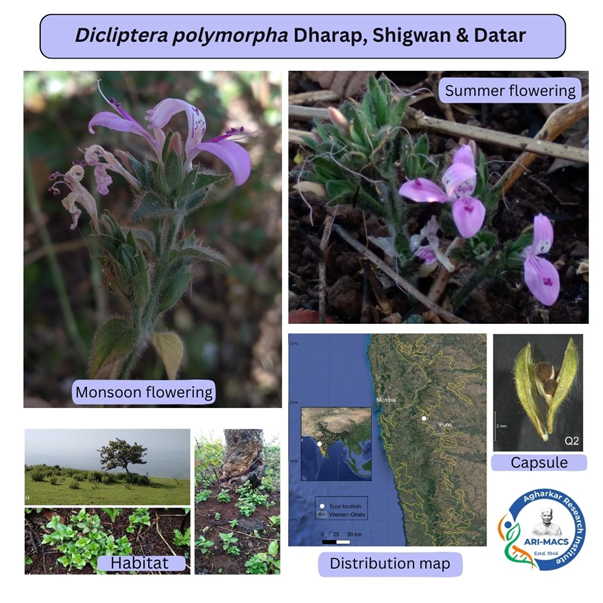A new fire resilient dual blooming species experiences a burst of flowering triggered by the grassland fires and has an inflorescence structure that is rare in Indian species has been discovered in the Western Ghats which is known to harbour many yet-to-be-discovered species.
The Western Ghats, one of India's four global biodiversity hotspots, has long been a focus of exploration by the Agharkar Research Institute (ARI), Pune, an autonomous institute under the Department of Science & Technology (DST). Over the past few decades, ARI scientists have been intensively studying the region's rich biodiversity.
A recent discovery by a team led by Dr. Mandar Datar, including Talegaon-Dabhade based botanist Adittya Dharap and Ph.D. student Bhushan Shigwan, has added a new species to the genus Dicliptera, which they have named Dicliptera polymorpha. The species was collected from Talegaon- Dabhade, which is known region for its grasslands and fodder markets.
Dicliptera polymorpha is a distinctive species, notable for its fire-resilient, pyrophytic habit and its unusual dual-blooming pattern. In addition to its typical post-monsoon flowering, the species exhibits a second, vigorous burst of flowering triggered by the grassland fires commonly set by locals in the region. This species is taxonomically unique, with inflorescence units (cymules) that develop into spicate inflorescences. It is the only known Indian species with this spicate inflorescence structure, with its closest allied being found in Africa.
The species was named Dicliptera polymorpha to reflect its diverse morphological traits. The
first specimens were collected during the 2020 monsoon, and the population was monitored by Adittya Dharap for next few years to confirm the consistency of its characteristics. The species' novelty was confirmed by leading global expert Dr. I. Darbyshire from Kew Botanic Garden, London. A research paper detailing this species was recently published in the prestigious journal Kew Bulletin.
Dicliptera polymorpha thrives on slopes in open grasslands of the northern Western Ghats, an area exposed to extreme climatic conditions such as summer droughts and frequent human-induced fires. Despite these harsh conditions, the species has adapted to survive and bloom twice a year. The first flowering phase occurs from post-monsoon (early November) to March or April, while the second flowering phase in May and June is triggered by fires. During this second phase, the woody rootstocks produce dwarf flowering shoots, leading to a more abundant but shorter flowering period.
The discovery of Dicliptera polymorpha holds important conservation implications. The species' unique adaptation to fire and its limited habitat range in the Western Ghats highlight the need for careful management of grassland ecosystems. Frequent human-induced fires, while part of the species' life cycle, must be balanced to prevent habitat degradation that could threaten its survival. Protecting the grasslands from overuse and ensuring that fire management practices support biodiversity are crucial steps in conserving this newly discovered species.
This discovery underscores the importance of preserving the Western Ghats' delicate ecosystems, which harbour many yet-to-be-discovered species with unique adaptations.
Publication link: https://link.springer.com/article/10.1007/s12225-024-10203-6
For further details, please contact Dr. Mandar Datar (mndatar[at]aripune[dot]org), Scientist, Biodiversity and Palaeobiology Group, or Dr. P.K. Dhakephalkar, Director ARI, Pune (director[at]aripune[dot]org).

Figure 1: Dicliptera polymorpha






























